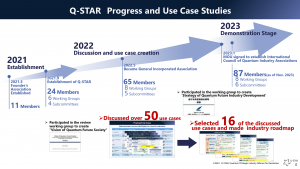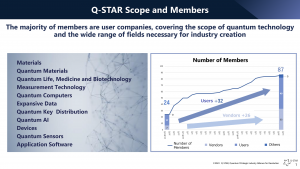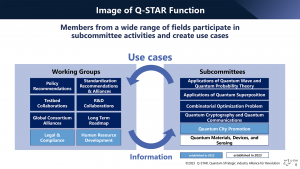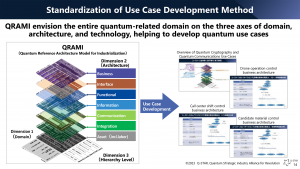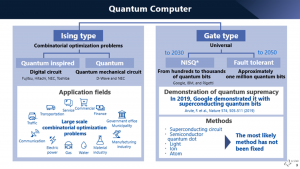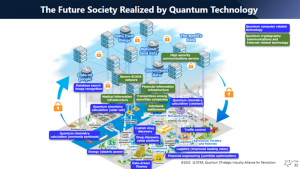Japan’s Q-STAR propels quantum technology’s global impact, emphasising practical applications and prioritising collaboration and societal problem-solving.
Q-STAR (Quantum STrategic industry Alliance for Revolution) was established in Japan in September 2021 to create new industries and business opportunities based on quantum technology. Its members come from various business sectors, including startups, small and medium-sized enterprises, large corporations, and academic institutions.
Q-STAR proactively collaborates with organisations in diverse fields globally, transcending industry and corporate boundaries to develop the quantum technology-related business of the future.
We have set five missions to achieve our goal:
- Build a society where the use of quantum is for everyone — by 2030, 5-10% of the population in major developed countries will be using quantum technology;
- Promote the globalisation of quantum technology — advancing the progress and application of quantum technology through international co-operation alongside accelerating economic globalisation;
- Support business opportunity creation by applying quantum technologies — support the participation of quantum vendors and users in the venture business market, expanding the scope of the quantum industry;
- Promote the quantum industry by training human resources and widely disseminating information — developing a programme to recruit and train workers in quantum and related fields, making it clear that implementation of quantum is essential for the future; and
- Promote industrialisation through the collaboration of industry, government, and academia collaboration — we propose a forum, Quantum United, for industry-government-academia collaboration for various countries
We emphasise more on creating business with quantum rather than academically researching quantum technology.
How are quantum technologies applied so far?
Our focus is not simply on the implementation of quantum technology but on its creation and the creation of a path to a future that includes peripheral industries. We believe that we can promote the social implementation of quantum by broadening the scope of our activities to include quantum-inspired technologies and hybrid environments with existing computer technologies.
Currently, Q-STAR has six subcommittees and eight working groups. Subcommittees are developing use cases, and working groups are giving helpful information to subcommittees. Q-STAR now has 87 members (as of November 2023), many of which are user companies. This is the most important feature of Q-STAR. These user companies proactively participate in the subcommittees with vendor companies to develop use cases.
To date, Q-STAR has discussed over 50 quantum-technology use cases, selected 16 of them to be followed up on as the next step, and made their industry roadmap.
We use the quantum reference architecture model for industrialisation (QRAMI) as a tool for the standardisation of use cases. QRAMI was inspired by RAMI 4.0 as a model for viewing quantum business. It envisions the entire quantum-related domain on the three axes of domain, architecture, and technology, helping to develop quantum use cases. We aim to make it a global tool, a platform for common understanding, not only within Q-STAR but also with other industrial consortiums around
the globe.
In this way, putting use cases to practical use is the key to applying quantum technology to society faster. We expect to expand the technology to various industries, such as healthcare, finance, logistics, factories, transportation, etc.
The future of quantum technology
The future we seek is to solve the present issues in society with quantum technology. We are trying to find ways to use quantum technology to solve these problems. Moreover, we aim to lead the world in quantum industry businesses and want to bring quantum technology to the lives of 5-10% of Japanese citizens in the near future.
We consider the following as the main challenges to implementing the technology socially:
- Early linkage and demonstration of quantum technology with classical computer technology;
- Increasing experience of actual machine use and user-driven proposed use cases; and
- Establishing benchmarks/standards
Q-STAR’s efforts to solve these issues
Q-STAR emphasises collaboration among sectors such as government, academia, and industry. Recently, Q-STAR member companies, representatives of academia, and national institutes outside the council have been discussing an open software platform that is not dependent on the type of quantum computer. The plan here is to visualise a hierarchy extending from customer issues to various calculation methods, and to build a hypothesis for practical use as a platform.
Moreover, Q-STAR signed an MoU with three other overseas consortiums, such as QED-C (USA), QuIC (Europe), and QIC (Canada), to build a collaborative relationship.
The quantum industry is still in its infant stage of development. As for gate-type quantum computers, it may take years for social implementation to be realised. However, as for ising-type computers (also called annealing-type computers) and quantum-inspired computers, they have already been shifting to the demonstration phase, and cases of their applications are beginning to emerge.
Many technologies can be combined with quantum technology. It is Q-STAR’s role to take these combined technologies and create business opportunities with them.
Please note, this article will also appear in the sixteenth edition of our quarterly publication.


